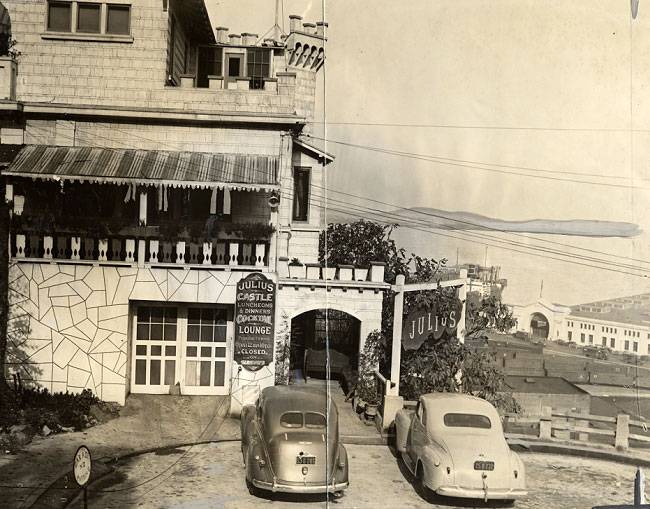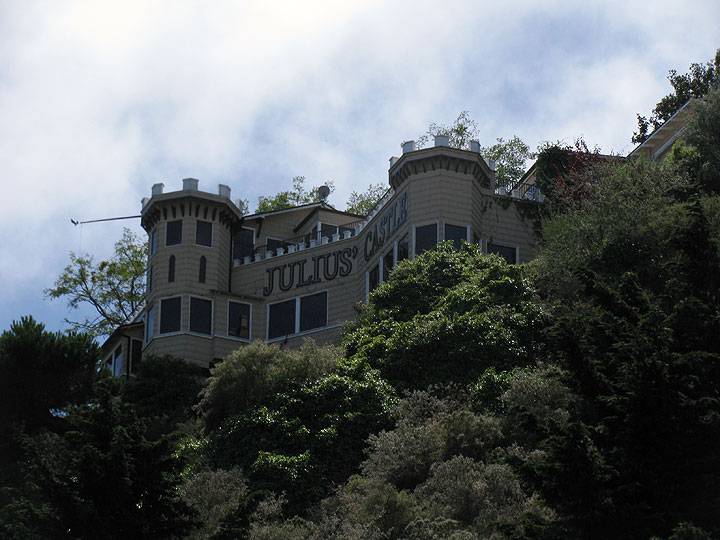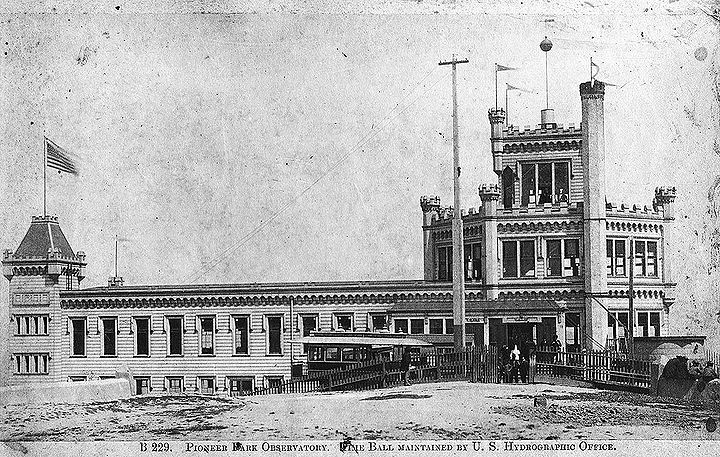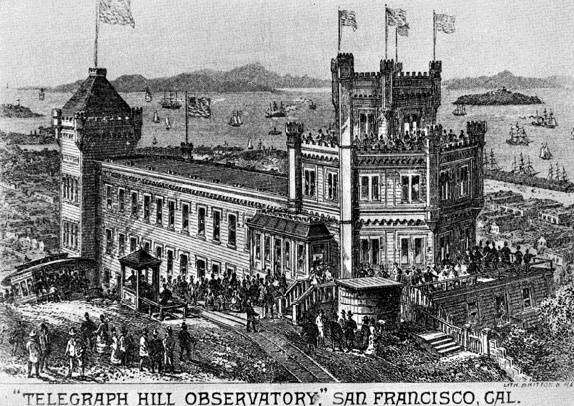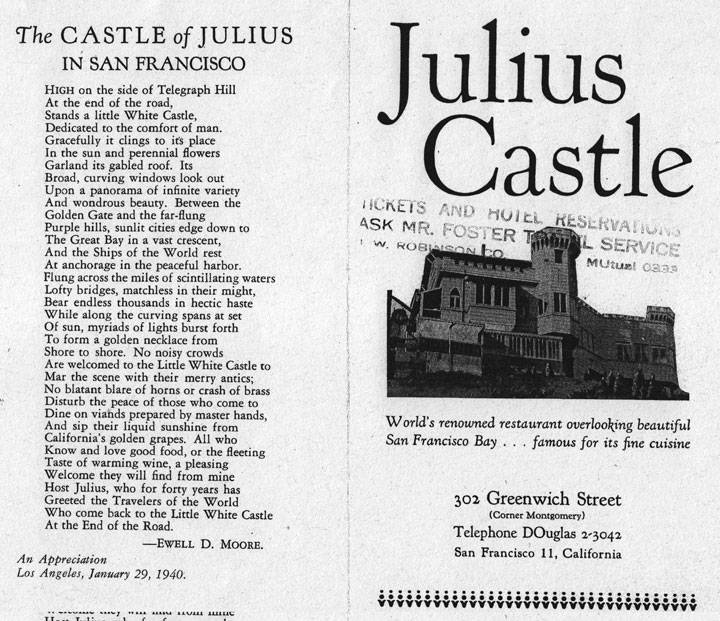Julius' Castle
Historical Essay
by Catherine Accardi, originally in The Semaphore #196, Fall 2011 under the title "Castle on the Hill"
Julius' Castle in the late 1940s.
Photo: Ben Valdez
Julius' Castle in the 1940s
Photo: San Francisco History Center, San Francisco Public Library
Castle “(from Latin castellum) a type of fortified structure built and inhabited in Europe during the Middle Ages by European nobility.”
Rarely does one find a castle clinging to a hill in the center of an urban area. Julius’ Castle, at 302 Greenwich St. where it meets Montgomery Street, is the exception. The castle, while certainly well built (although not quite “fortified”), was the residence and business establishment of a beloved San Francisco “noble” by the name of Julius Roz. Julius’ Castle was a leading San Francisco restaurant for more than 87 years, and is San Francisco landmark No. 121, designated as such on Oct. 5, 1980.
As seen in 2012 from Lombard and Montgomery.
Photo: Chris Carlsson
The History
So, how did this urban castle come to be? It all began with building permit No. 114873 (dated March 20, 1923), when Roz, a local Italian restaurateur, began work on the castle-like structure perched on one of Telegraph Hill’s many precipices. In 1886, the site had been the location of Michael Crowley’s two-story grocery store. Later, the John Mini family built their home there only to have it destroyed around 1918 by fire. In 1924, less than a year after construction on the Castle began, food service was under way, establishing Julius’ Castle’s as among the oldest San Francisco restaurants at its original location with its original name.
With Roz’s collaboration, civil engineer and architect Louis Mastropasqua designed this amazing structure that combines fairytale elements, such as pointed arched windows and medieval-style battlements on the upper balconies, all mixed with Gothic Revival and Arts-and-Crafts influences. Interior wood paneling was reputedly purchased by Roz from the city’s 1915 Panama Pacific International Exposition. The words “Julius’ Castle,” on redwood on the front, were added by Roz in 1928.
At the time, Montgomery Street was little more than a dirt trail wide enough for one vehicle. Because the street was so narrow, a turntable was installed in 1931 at the dead-end in front of the castle and an employee turned cars around and parked them. During Prohibition, Julius’ Castle became a speakeasy for the carriage trade. Its patrons watched the Bay Bridge being constructed and completed in 1936. Regulars also witnessed the apparition of Treasure Island as it was dredged from the bottom of the bay for the World’s Fair of 1939-40. They also saw the wartime fleet moving in and out during World War II.
When Julius Roz died in 1943, the property passed through several owners, though it has always retained its name. It had been a popular celebrity hangout for local politicians (Table 34 was the mayor’s table), musicians such as Huey Lewis and Hollywood actors, including Robert Redford, Cary Grant, Sean Connery, Marlon Brando and Ginger Rogers. Even famed Mount Everest climber Sir Edmund Hillary was a patron.
With help from the Telegraph Hill Dwellers, the property earned landmark status in 1980, just prior to purchase by San Franciscan Jeffrey Pollack. The local restaurant mogul would become the castle’s longest-running proprietor, owning and operating it for 26 years. The Pollacks sold the property to Jim Payne in 2006. He refurbished the interior, made several interior alterations and reopened in 2007, only to close in 2008. So it remains, closed and seemingly abandoned after operating as a restaurant for more than 80 years.
Mr. Julius Roz
Julis Roz was born in Turin, Italy, around 1868. He arrived in San Francisco in 1902, working in various North Beach restaurants as a bus boy and waiter. Later, he became manager of several eateries, including the Dante Restaurant at 536 Broadway. At Julius’ Castle, he was all things to the restaurant: buyer, chef and maître d’. A 1939 city guide comments on Roz’s cooking: “To taste his fish sauce supreme, his tagliarini and his banana soufflé is to have a glimpse of an epicure’s heaven.”
He was friends with many other local business persons and residents, including Harry Lafler, an artist and newspaperman and owner of the “Compound,’’ consisting of five or so cottages where artists lived, just across the street from Julius Castle. Thus Roz’s association with Bohemian North Beach.
Roz lived in the apartment above the restaurant with his wife, daughter and two dogs, from which he was inseparable. Elmer Gavello, of Lucca’s restaurant, describes seeing Roz with his dogs. “I’ll never forget him driving down Union Street in North Beach in a yellow Chrysler Imperial convertible…He always had the convertible’s top down and two beautiful collie dogs in the rumble seat, which had its own windshield and side windows to keep the wind off the dogs…What a magnificent sight!”
The Architect, Louis Mastropasqua
Louis Mastropasqua was born in Brescia, Italy, near Milan, in 1870, graduating in 1899 from the Italian Royal Polytechnic School, specializing in civil engineering and architecture. He traveled, studying architecture and art in Japan, China and Africa before his arrival at San Francisco in 1902. He spoke no English, but quickly learned the language and established himself as an architect of repute in the Italian community, especially after the building boom following the 1906 earthquake and fire. In the 1923 Crocker Langley City Directory, his office address was 580 Washington St., where he was listed as architect and civil engineer.
One of Mastropasqua’s first designs was the Nunziato pasta factory at 415 Broadway near Montgomery. In addition, he designed a number of residences, including the Charles Bovone house (1908) at 68 Macondray. He was also a noted cartoonist for the Italian paper “La Vita Italiana.”
Layman's "German" Castle atop Telegraph Hill, 1890s.
Photo: San Francisco History Center, San Francisco Public Library
Historic records indicate Mastropasqua’s collaboration with Roz on the unique design of the Castle was in part inspired by Frederick O. Layman’s wooden castle, which had stood nearby atop Telegraph Hill between 1882 and 1903. Layman built the “German” castle as a business venture and cable car terminus of his proposed observatory and restaurant. Known to residents as “Layman’s Folly,” the structure was destroyed by fire in 1903. As Roz and Mastopasqua had arrived in San Francisco from Italy in 1902, they were able to ponder the first “Castle” on Telegraph Hill. Apparently, this gazing was inspirational, as 20 years later Julius’ Castle was created.
"Layman's Folly" atop Telegraph Hill (1883-1903)
Image: Greg Gaar Collection, San Francisco, CA
Roz’s castle was well thought out, achieving a unique restaurant setting on a world famous hill, providing customers with unparalleled views, providing neighboring residents with quite a sight, visible from down the street, down the hill, from the waterfront and from passing ships.
The Landmark
Well, of course it’s a landmark! The San Francisco Department of City Planning’s 1976 Architectural Survey bestowed a “high quality rating” on our neighborhood gem. The survey classifies Julius’ Castle’s style as “Miscellaneous Exotic,” with its main component styles as Gothic Revival and Arts-and-Crafts. It is a wood-frame building over a concrete foundation. A basement contains the compressor room, storage, wine cellar in a former garage and a loggia leading to the restaurant. The main floor houses the kitchen and the approximately 64-seat restaurant. The apartment is above. The landmark report, available for viewing at the San Francisco Planning Department, is a wealth of detailed information regarding the Castle’s architectural merit.
With help from the Hill Dwellers, the property earned landmark status in 1980, just prior to purchase by Jeffrey Pollack.
In the Media:
The booklet, “Bohemian Eats of San Francisco” by Jack L. and Hazel Blair Dodd describe the Julius Castle ambience and dining experience:
“…Should you get lost on the way up the hill, the small boy by the roadside will give you directions as only a small boy can. Many Italian eateries display their national colors of red, green and white. Here you can eat them in the form of red, green, and white tagliarini. As you arrive, and during your meal, Sandy will greet you with a smile and tail wag as Sandy is a collie dog. He will ask to play with you. Sandy has played with such celebrities as Jackie Coogan, Lon Chaney and Douglas Fairbanks. Yes, indeed, your host Julius Roz, has received radiograms from ships at sea on their return, asking that reservations be made for passengers as soon after their ship docks as is possible. Lunch from 12 to 2, $1.50 — Dinner from 6 to 9, $2.00.”
In Films:
“The House on Telegraph Hill” – 1951. 20th Century Fox, Director: Robert Wise According to film archives, 20th Century Fox used the front of Julius’ Castle in this movie. Creative changes to the structure’s image were made so that it would look like the entrance to a stately home. These alterations to the exterior were created by building a façade around the castle.
“The Raging Tide” (1951) Universal International Pictures, Director: George Sherman One scene from this movie shows Shelly Winters running out of Julius' Castle, pausing on the entrance steps for an emotional dialogue. City lights are the backdrop. In another scene, Winters is having brandy at the bar in Julius Castle talking to a bartender.
San Francisco History Room, SF Public Library
My contact with the property’s leasing and sales associate brought unfortunate news. The Castle has neither been leased nor sold. It continues to sit empty, occupied only by memories.
The concern is that, although a registered San Francisco landmark, the designation can be nullified and demolition could ensue, according to a San Francisco ordinance that states that to tear down a city landmark, owners must prove there is no economic use for the property. If the structure is vacant, not being used in three years for its intended purpose (in this case a restaurant), the landmark status can be voided. Nowadays, the Castle sits empty, abandoned and seemingly unloved. Just one more time, I want to walk by 302 Greenwich and imagine two frisky collies running around and the delicious aroma of Italian sauce mixing in nicely with cool bay breezes.
Catherine Accardi is a native San Franciscan born on Telegraph Hill. She has been a long-standing member of Telegraph Hill Dwellers and the San Francisco Historical Society. In 2010, her book San Francisco’s North Beach and Telegraph Hill, was published by Arcadia Publishing. Her latest book, Images of America-San Francisco Landmarks, was released in the winter of 2012. She welcomes other information readers may have about Julius’s Castle. She may be contacted at contact me at caacat@comcast.net.


